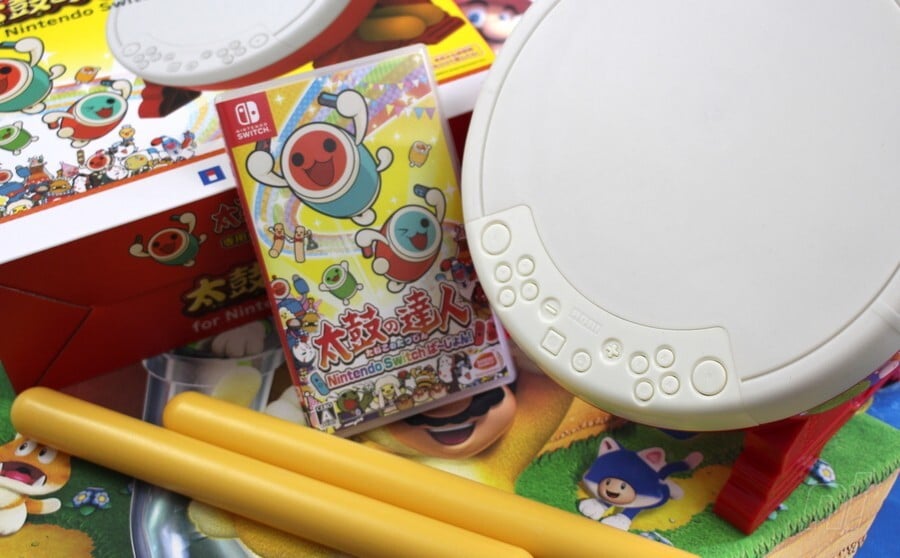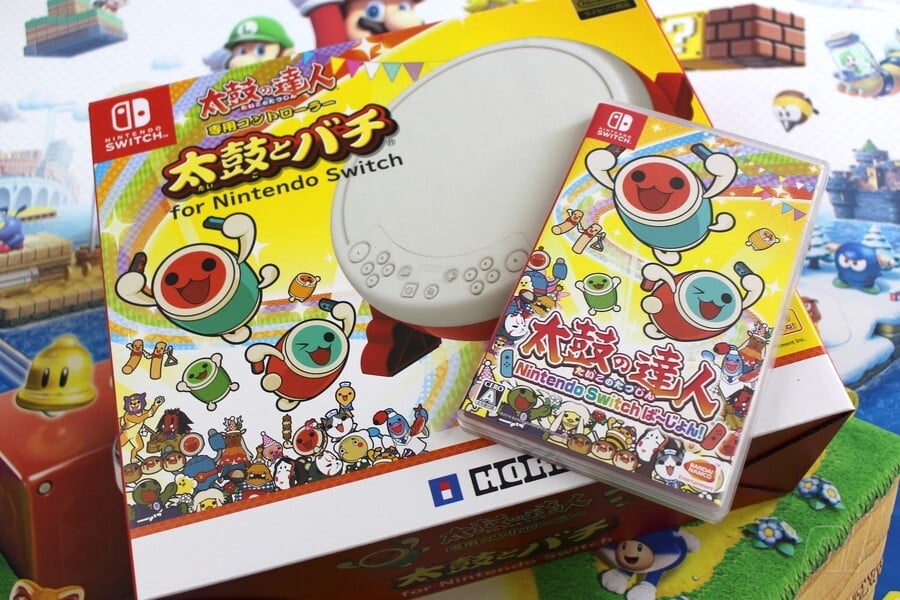
It's incredible to think that despite the amazing success and fame of the Taiko no Tatsujin series, only one entry has been released in the west up to now – 2004's Taiko: Drum Master. Thankfully, that will change later this year with the Nintendo Switch release of Taiko no Tatsujin: Drum 'n' Fun, previously launched in Japan as Taiko no Tatsujin: Nintendo Switch Version. Given that the Japanese version is now totally playable in English – and that the tracklisting is pretty much identical – we decided to dive into the import edition to give you a little preview before the western version launches in November.
In case you didn't know, Taiko no Tatsujin is a rhythm action franchise which began life in arcades way back in 2001. The core gameplay is simple; you hit a drum with two sticks in time with the music. The Switch version naturally retains this setup, with red icons denoting a hit on the drum's skin while blue icons instruct you to hit the rim of the drum. Large icons call for you to use both sticks to perform the hit, but the game is happy to register a single hit as well.
Given the variety of control inputs available on Switch, it should come as no surprise to learn that you've got multiple interface options when approaching this version of Taiko no Tatsujin. When playing in handheld mode you might prefer to use the Joy-Con buttons; both the face and shoulder buttons can be used to perform the two different types of strike and it's relatively easy to get your timing right using this method. The only problem is that on the harder songs it can be difficult to pick out each strike type, especially when the commands speed up.
Touch controls are a far better option if you're playing in portable mode, if we're honest. Here, a drum is shown on-screen and can be tapped with your digit to register a strike; strikes on the rim (blue) are performed by tapping outside of the drum. You can use two fingers in this mode, which drastically improves your input time and makes even the toughest tracks easy to master – assuming you've got timing and rhythm, of course.
Much fuss has been made of the game's motion controls, and on face value, it would certainly seem like Switch is the ideal platform for such a title, given that the Joy-Con can be held like drumsticks. While it's true that the controllers are ideal for this kind of thing, the usual complaints arise when the action hots up – motion controls simply aren't accurate enough to pick out the difference between the two strike types (you swing down vertically for red notes, and perform a sort of diagonal slash for blue ones), and when you've got notes packed close together, the game often fails to acknowledge more rapid movements. It's a real shame because the Joy-Con offer the only realistic means of exploiting the game's multiplayer mode (more on that in a second).
If you're feeling especially flush then you can opt for what is, without a doubt, the preferred interface method for Taiko no Tatsujin – the drum controller. Manufactured by Hori, this device replicates the drum seen on the arcade original and comes with two plastic sticks. It connects to your Switch dock via a USB lead (so you can't use it in tabletop mode, sadly) and comes with a selection of controls on the bottom which allow you to navigate menus, take screenshots, pause the game and drop back to the Home menu.
Playing Taiko no Tatsujin with the drum controller is pure bliss; it's accurate and feels authentic. We didn't notice too many bum notes, either – on the whole, the drum registered our strikes without any issue whatsoever. It's a shame then that this peripheral drives up the cost of ownership so sharply; at the moment, Bandai Namco has confirmed that the drum controller is coming to the west, but hasn't said if some kind of bundle offer will be made available. While the alternate controls are perfectly serviceable – especially the touch-based option – Taiko no Tatsujin was designed to be played with the drum.
The track listing comes with a few Nintendo-centric bonuses, including themes from Super Mario Odyssey, Kirby and Splatoon. The remainder of the roster strikes a mix between Japanese rock and pop (One Night Carnival by Kishidan is a highlight; we have happy memories of the song from the seminal DS title Osu! Tatakae! Ouendan), anime themes, Namco game music (drumming to the Ridge Racer theme is surprisingly good fun) and other tunes. DLC tracks are also available, meaning there's certainly no shortage of songs here.
Taiko no Tatsujin is a pretty no-frills package. You work your way through the tracklisting earning bronze, silver and gold crowns for your efforts, and doing so unlocks more songs to drum along to. However, there's no single-player story mode to tie any of this together; you're just tapping to tunes, improving your score and moving onto the next song. It's a shame more couldn't have been made of the solo portion of the title, but we assume the developers have made multiplayer the focus with this particular release, given the wide array of potential control options on Switch.
With this in mind, there's a cavalcade of mini-games to play with friends, all of which are based around finding the right rhythm. One plays like a smartphone 'endless runner' title (aside from the fact that it's, erm, not endless) where up to four players dash along a pixelated landscape gobbling food to the beat. Another turns you into drum-shaped bumblebees who have to challenge one another to grab the nectar from a flower when it opens – all in time to the music, of course. Another game is about scooping fish from a tank, while yet another sees you slashing wooden logs with your ninja sword. These mini-games aren't particularly deep, but they're brilliant fun when played with a room full of friends.

As we've already noted, a recently-released patch means that the Japanese edition of Taiko no Tatsujin is fully playable in English – you don't even have to change anything in the options, as the game detects your console's default language and alters the text accordingly. There's literally no barrier to entry whatsoever if you're an English-language player, and given that the track listing is largely the same, there's no genuine reason to sit and wait for the western release if you're dying to play right now, outside of the possibility that it may end up being cheaper than importing from the far east.
Outside of some minor issues with some of the control options and the lack of any real single-player mode to keep solo players invested, we can't see any reason why seasoned Taiko no Tatsujin fans will be disappointed in this latest offering. If you decide to keep your powder dry until November, then rest assured that you'll have another couch-play classic in your Switch library – just make sure you buy it with the drum controller for the full experience.
Please note that some external links on this page are affiliate links, which means if you click them and make a purchase we may receive a small percentage of the sale. Please read our FTC Disclosure for more information.







Comments 17
I really miss Donkey Conga sometimes lol
Bought the PS4 version in Taiwan, will buy the Switch version too. Gotta say that I prefer playing with the gamepad because it's more accurate and I hate that you can't use the controller with both the PS4 and Switch versions. It's USB, it should be possible.
Great game though. Don't like motion controls, but some people seem to be very accurate:
@earthinheritor Yes I loved that game on the GameCube.
If it’s download only in USA (and I believe it is) and won’t have drum, I’m not buying it unless dirt cheap... and I’m a big fan of the series. Sad. I shouldn’t have to import a Japanese copy to get it physically. I guess I should be happy it’s getting released at all though.
Donkey Konga please, Nintendo.
beat saber is way better
@JoeyJoey95 Didn’t realize. At least I can import an English physical version if I feel like it. That just makes it sillier since that version could easily be sold in the US.
@JoeyJoey95 It's a rhythm game with an expensive accessory with Japanese music. Of course they are careful before they waste millions.
I'm also happy they didn't localize the music. That was horrible in Rhythm Tengoku/Heaven
Also enjoying this great game with the drums.
It is worth the money if you like the game
I play with buttons which is probably heresy but I’m 10 hours in and still enjoying the game & Ghibli dlc
@jockmahon User icon does NOT check out.
I saw gameplay and...meh, wished we could just use any song we want, or something...
Bought it since day 1. Still waiting for the drum peripheral to come in.
@JoeDiddley I got frustrated with getting destroyed in "normal" difficulty while using motion control, so I decided to cheat and use buttons. Then something shocking happened... I really didn't do any better! It's pretty embarrassing getting curb stomped by a game design for five year olds in Japan.
@TheFox ha, yes. I play for fun not honours myself.
@eef I know, it just gets better. It came out the same day as the English language patch. Annoyingly just over 500 yen so my 1000 Japanese credit probably won’t run to a future dlc pack
@Eef great, there is another piece of free dlc but that’s just one song
that motion control vid has given me hope. im going to go back to that. I wonder if i can use a converter and my wiiu tatacon...
@jockmahon But that's not a Switch game. Are you asking for it to be on Switch? And is it a possible port?
Tap here to load 17 comments
Leave A Comment
Hold on there, you need to login to post a comment...